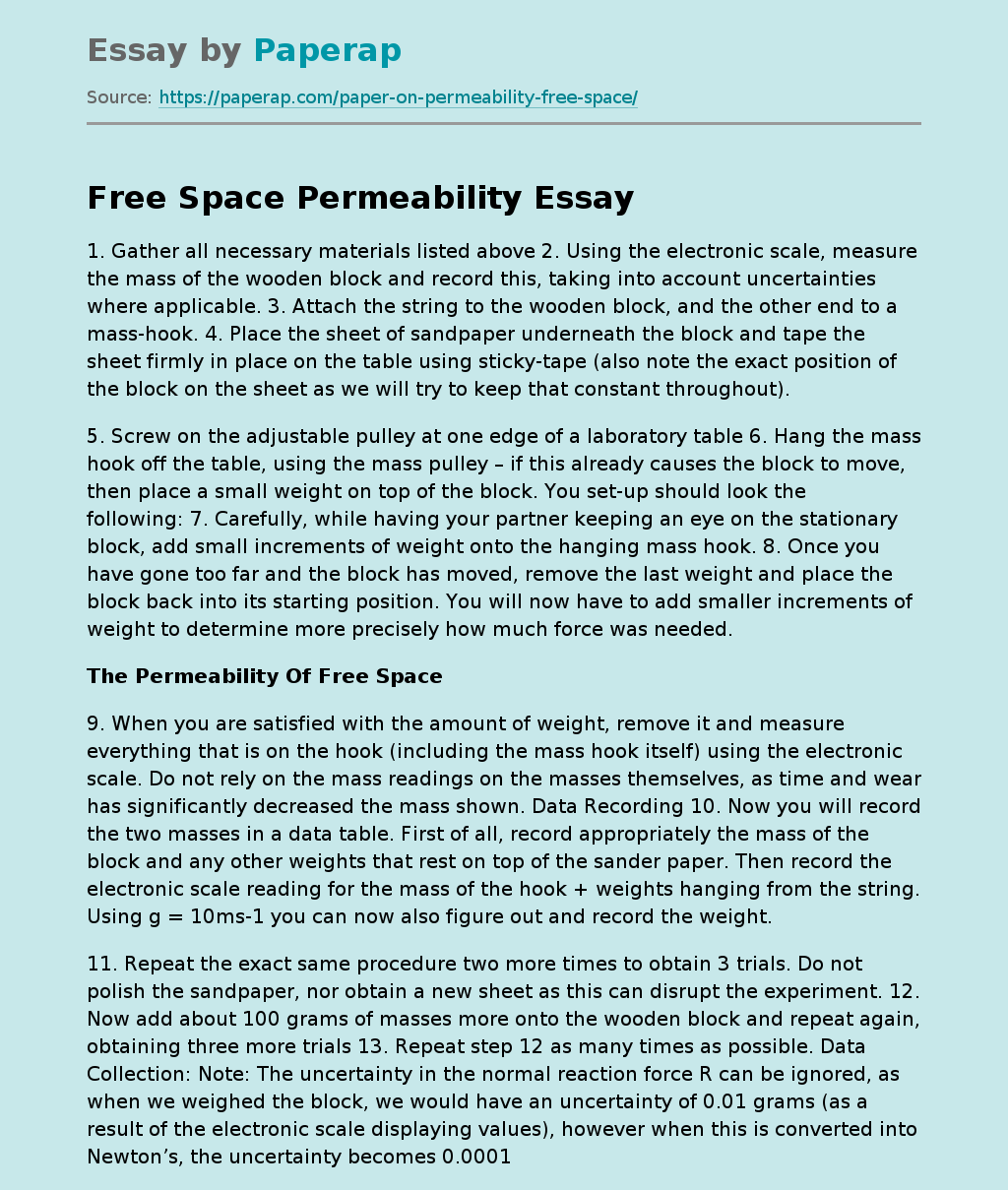Free Space Permeability
1. Gather all necessary materials listed above 2. Using the electronic scale, measure the mass of the wooden block and record this, taking into account uncertainties where applicable. 3. Attach the string to the wooden block, and the other end to a mass-hook. 4. Place the sheet of sandpaper underneath the block and tape the sheet firmly in place on the table using sticky-tape (also note the exact position of the block on the sheet as we will try to keep that constant throughout).
5. Screw on the adjustable pulley at one edge of a laboratory table 6. Hang the mass hook off the table, using the mass pulley – if this already causes the block to move, then place a small weight on top of the block. You set-up should look the following: 7. Carefully, while having your partner keeping an eye on the stationary block, add small increments of weight onto the hanging mass hook. 8. Once you have gone too far and the block has moved, remove the last weight and place the block back into its starting position.
You will now have to add smaller increments of weight to determine more precisely how much force was needed.
The Permeability Of Free Space
9. When you are satisfied with the amount of weight, remove it and measure everything that is on the hook (including the mass hook itself) using the electronic scale. Do not rely on the mass readings on the masses themselves, as time and wear has significantly decreased the mass shown.
Data Recording 10. Now you will record the two masses in a data table. First of all, record appropriately the mass of the block and any other weights that rest on top of the sander paper. Then record the electronic scale reading for the mass of the hook + weights hanging from the string. Using g = 10ms-1 you can now also figure out and record the weight.
11. Repeat the exact same procedure two more times to obtain 3 trials. Do not polish the sandpaper, nor obtain a new sheet as this can disrupt the experiment. 12. Now add about 100 grams of masses more onto the wooden block and repeat again, obtaining three more trials 13. Repeat step 12 as many times as possible. Data Collection: Note: The uncertainty in the normal reaction force R can be ignored, as when we weighed the block, we would have an uncertainty of 0.01 grams (as a result of the electronic scale displaying values), however when this is converted into Newton’s, the uncertainty becomes 0.0001, which is so small, it can be ignored. To find the average force of friction, I added up the 3 trial forces of friction and divided it by the number of trials (3). Sample calculation:
When averaging the force of friction, I also had to take care of the uncertainties of each force of friction trial (0.05N) and I did this by estimating the uncertainty from the several repeated measurements. Since we are adding the three values, this means I had to add the 3 uncertainties. This gives the value of (0.05) + (0.05) + (0.05) = 0.15 N To find the coefficient of friction �, the formula can be used, where is the frictional force, is the coefficient we are looking for, and R is the reaction force. Rearranging the formula, we obtain the formula for finding the coefficient directly;
Note that this will give use the static coefficient of friction, which is different from the dynamic coefficient, but is what we were instructed to find in this particular lab. To find our average coefficient of static friction, taking into account all the tests and all the trials, we would have (0.76 + 0.77 + 0.77 + 0.78 + 0.79) / 5 = = 0.77 0.05 On the following page you will find a graph that plots the frictional force Ffr versus the normal reaction force R. There is a clear linear relationship between the two forces, and this line should, ideally, pass through the origin.
Uncertainties, and moreover, systematic error, have caused this line shift. For example, the friction of between the puller and the string meant that not all of the weight of the mass was transferred to pull the block, but since this happened every time, the relationship still holds although it is not from the origin. Moreover, as we continued carrying out this experiment, one must keep in mind that the sandpaper was getting more and more “worn”, which reduces friction for the consequential trials.
Free Space Permeability. (2019, Dec 05). Retrieved from https://paperap.com/paper-on-permeability-free-space/

